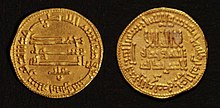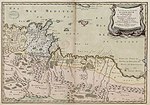Aghlabids: Difference between revisions
Content deleted Content added
Extended confirmed users 14,230 edits |
Extended confirmed users 14,230 edits |
||
| Line 12: | Line 12: | ||
Under [[Ziyadat Allah I]] (817-838) came the crisis of a revolt of Arab troops in 824, which was not quelled until 836 with the help of the Berbers. The [[Muslim conquest of Sicily|conquest of Byzantine Sicily]] from 827 under [[Asad ibn al-Furat]] was an attempt to keep the unruly troops under control - it was only achieved slowly, and only in 902 was the last Byzantine outpost taken. Plundering raids into mainland [[Italy]], which included the [[Sack of Rome (846)|sack of Rome]] in 846,<ref>Barbara M. Kreutz, ''Before the Normans: Southern Italy in the Ninth and Tenth Centuries'', (University of Pennsylvania Press, 1991), 57.</ref> took place until well into the 10th century. Gradually the Aghlabids lost control of the Arab forces in Sicily and a new dynasty, the [[Kalbids]], emerged there. |
Under [[Ziyadat Allah I]] (817-838) came the crisis of a revolt of Arab troops in 824, which was not quelled until 836 with the help of the Berbers. The [[Muslim conquest of Sicily|conquest of Byzantine Sicily]] from 827 under [[Asad ibn al-Furat]] was an attempt to keep the unruly troops under control - it was only achieved slowly, and only in 902 was the last Byzantine outpost taken. Plundering raids into mainland [[Italy]], which included the [[Sack of Rome (846)|sack of Rome]] in 846,<ref>Barbara M. Kreutz, ''Before the Normans: Southern Italy in the Ninth and Tenth Centuries'', (University of Pennsylvania Press, 1991), 57.</ref> took place until well into the 10th century. Gradually the Aghlabids lost control of the Arab forces in Sicily and a new dynasty, the [[Kalbids]], emerged there. |
||
It is recorded that despite the political difference between Aghlabids who served under [[Abbasid]] and the [[Emirate of Córdoba|Ummayad Emirate of Cordoba]]. The Muslims in Spain was also sent a fleet under Asba' ibn Wakil to aid the Aghlabids conquest of [[Sicily]]. Ibn Kathir recorded that 300 ships totals of Umayyad and Aghlabids joint forces were present<ref>{{cite book |last=El Hareir, Mbaye |first=Idris , Ravane |authorlink= |ref=|title=The Spread of Islam Throughout the World |language= English |url=https://books.google.co.id/books?id=qVYT4Kraym0C&pg=PA306&dq=abdullah+zubayr+gregor&hl=en&sa=X&ei=P4j0VI2BF42puwSz84CoDQ&ved=0CCwQ6AEwAw#v=onepage&q=sicily&f=false |year=2011 |publisher=[[UNESC]] |isbn=9231041533 |page= 441 |pages=949}}</ref> |
|||
The Aghlabid kingdom reached its high point under [[Ahmad ibn Muhammad al-Aghlabid]] (856-863). Ifriqiya was a significant economic power thanks to its fertile agriculture, aided by the expansion of the [[Roman Empire|Roman]] irrigation system. It became the focal point of trade between the Islamic world and Byzantium and Italy, especially the lucrative slave trade. Kairuan became the most important centre of learning in the [[Maghreb]], most notably in the field of [[Theology]] and [[Law]], and a gathering place for poets. The Aghlabid Emirs also sponsored building projects, notably the rebuilding of the [[Mosque of Uqba]] and the kingdom developed an architectural style which combined [[Abbasid architecture]] and [[Byzantine architecture]].<ref name=DictIslamArch>{{cite web|title=Aghlabids|url=http://archnet.org/library/dictionary/entry.jsp?entry_id=DIA0005&mode=full|work=Dictionary of Islamic Architecture|publisher=Archnet|accessdate=23 January 2011}}</ref> |
The Aghlabid kingdom reached its high point under [[Ahmad ibn Muhammad al-Aghlabid]] (856-863). Ifriqiya was a significant economic power thanks to its fertile agriculture, aided by the expansion of the [[Roman Empire|Roman]] irrigation system. It became the focal point of trade between the Islamic world and Byzantium and Italy, especially the lucrative slave trade. Kairuan became the most important centre of learning in the [[Maghreb]], most notably in the field of [[Theology]] and [[Law]], and a gathering place for poets. The Aghlabid Emirs also sponsored building projects, notably the rebuilding of the [[Mosque of Uqba]] and the kingdom developed an architectural style which combined [[Abbasid architecture]] and [[Byzantine architecture]].<ref name=DictIslamArch>{{cite web|title=Aghlabids|url=http://archnet.org/library/dictionary/entry.jsp?entry_id=DIA0005&mode=full|work=Dictionary of Islamic Architecture|publisher=Archnet|accessdate=23 January 2011}}</ref> |
||
Revision as of 19:03, 2 March 2015
| Historical Arab states and dynasties |
|---|
 |


The Aghlabids (
Fatimids
.
History
In 800, the Abbasid Caliph Harun al-Rashid appointed Ibrahim I ibn al-Aghlab, son of a Khurasanian Arab commander from the Banu Tamim tribe,[2] as hereditary Emir of Ifriqiya as a response to the anarchy that had reigned in that province following the fall of the Muhallabids. He was to control an area that encompassed eastern Algeria, Tunisia and Tripolitania.[3] Although independent in all but name, his dynasty never ceased to recognise Abbasid overlordship.
A new capital,
Berbers. Additionally, border defenses (Ribat) were set up in Sousse and Monastir. The Aghlabids also built up the irrigation of the area and enhanced the public buildings and mosques.[3]
Under
sack of Rome in 846,[4] took place until well into the 10th century. Gradually the Aghlabids lost control of the Arab forces in Sicily and a new dynasty, the Kalbids
, emerged there.
It is recorded that despite the political difference between Aghlabids who served under
Abbasid and the Ummayad Emirate of Cordoba. The Muslims in Spain was also sent a fleet under Asba' ibn Wakil to aid the Aghlabids conquest of Sicily. Ibn Kathir recorded that 300 ships totals of Umayyad and Aghlabids joint forces were present[5]
The Aghlabid kingdom reached its high point under
Mosque of Uqba and the kingdom developed an architectural style which combined Abbasid architecture and Byzantine architecture.[6]
Decline of the Aghlabids
The decline of the dynasty began under
Qairawan and Raqqada and took an oath of allegiance from the people. By 909, the Aghlabid Dynasty was overthrown and replaced with the Fatimids.[7]
Aghlabid rulers
| History of Tunisia |
|---|
 |
|
|
| History of Algeria |
|---|
 |
- Ibrahim I ibn al-Aghlab ibn Salim (800–812)
- Abdallah I ibn Ibrahim(812–817)
- Ziyadat Allah I ibn Ibrahim(817–838)
- al-Aghlab Abu Iqal ibn Ibrahim(838–841)
- Abu 'l-Abbas Muhammad I ibn al-Aghlab Abi Affan(841–856)
- Ahmad ibn Muhammad al-Aghlabid (856–863)
- Ziyadat Allah II ibn Abil-Abbas(863)
- Abu 'l-Gharaniq Muhammad II ibn Ahmad (863–875)
- Abu Ishaq Ibrahim II ibn Ahmad (875–902)
- Abu 'l-Abbas Abdallah II ibn Ibrahim (902–903)
- Abu Mudhar Ziyadat Allah III ibn Abdallah (903–909)
See also
- History of Islam in southern Italy
- History of medieval Tunisia
- List of Sunni Muslim dynasties
- History of Algeria
- History of Libya
Citations
- ^ C.E. Bosworth, The New Islamic Dynasties, (Columbia University Press, 1996), 31.
- ^ C.E. Bosworth, The New Islamic Dynasties, 31.
- ^ ISBN 0-8133-3885-9.
- ^ Barbara M. Kreutz, Before the Normans: Southern Italy in the Ninth and Tenth Centuries, (University of Pennsylvania Press, 1991), 57.
- ISBN 9231041533.)
{{cite book}}: More than one of|pages=and|page=specified (help)CS1 maint: multiple names: authors list (link - ^ "Aghlabids". Dictionary of Islamic Architecture. Archnet. Retrieved 23 January 2011.
- ISBN 978-9960-89293-1.
References
- Georges Marçais, "Aghlabids," Encyclopedia of Islam, 2nd ed., Vol. I, pp. 699–700.
- Mohamed Talbi, Emirat Aghlabide, Paris: Adrien Maisonneuve, 1967.
- Madeleine Vonderheyden, La Berbérie orientale sous la dynastie des Benoû l-Aṛlab, 800-909, Paris: Geuthner, 1927.
